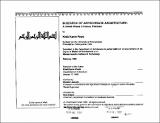| dc.contributor.advisor | Ronald Lewcock. | en_US |
| dc.contributor.author | Pirani, Khalil Karim | en_US |
| dc.contributor.other | Massachusetts Institute of Technology. Dept. of Architecture. | en_US |
| dc.coverage.spatial | a-pk--- | en_US |
| dc.date.accessioned | 2013-02-14T15:12:13Z | |
| dc.date.available | 2013-02-14T15:12:13Z | |
| dc.date.copyright | 1989 | en_US |
| dc.date.issued | 1989 | en_US |
| dc.identifier.uri | http://hdl.handle.net/1721.1/76872 | |
| dc.description | Thesis (M. Arch.)--Massachusetts Institute of Technology, Dept. of Architecture, 1989. | en_US |
| dc.description | Includes bibliographical references (p. 131-133). | en_US |
| dc.description.abstract | In today's world of technological advancement, communication has become easier than ever before. This, along with its benefits, has inflicted severe blows to architecture in developing nations. Concepts have been imitated and technologies transposed without any concern or regard for appropriateness. Changes have been accepted without a care for the past and without any sense of future direction. This indifferent attitude is proving detrimental to the future built environment of Third World countries. Hunza, a region located in the north of Pakistan and untouched until the last few years, is facing new challenges because of increased communication not only with developed parts of the country, but also with the rest of the world. Its natural beauty and difficult mountain terrain has attracted people from all over the world by way of the newly built Karakoram highway. In this hazy mist of change in Hunza, the local architecture is being severely affected. People are using new building materials in their own way of construction without any fear or concern. A search to establish a comprehensive base for an appropriate architecture in the spirit of Hunza is beyond the scope of this thesis, but an attempt has been made in my own way to discover an architecture responding to current needs and using appropriate materials, while keeping in sight Hunza's history, tradition and culture which the faith of the locals, Islam, demands. This thesis addresses these issues by using the design of a jamat khana in the village of Karimabad, Hunza, as a vehicle. A community building of this significance may help in providing a forum for local builders, masons and craftsmen where they can revitalize their traditional ideas and search for appropriate solutions -- whatever the need be. | en_US |
| dc.description.statementofresponsibility | by Khalil Karim Pirani. | en_US |
| dc.format.extent | vi, 133 p. | en_US |
| dc.language.iso | eng | en_US |
| dc.publisher | Massachusetts Institute of Technology | en_US |
| dc.rights | M.I.T. theses are protected by
copyright. They may be viewed from this source for any purpose, but
reproduction or distribution in any format is prohibited without written
permission. See provided URL for inquiries about permission. | en_US |
| dc.rights.uri | http://dspace.mit.edu/handle/1721.1/7582 | en_US |
| dc.subject | Architecture. | en_US |
| dc.title | In search of appropriate architecture : a jamat khana in Hunza, Pakistan | en_US |
| dc.type | Thesis | en_US |
| dc.description.degree | M.Arch. | en_US |
| dc.contributor.department | Massachusetts Institute of Technology. Department of Architecture | |
| dc.identifier.oclc | 20448977 | en_US |
